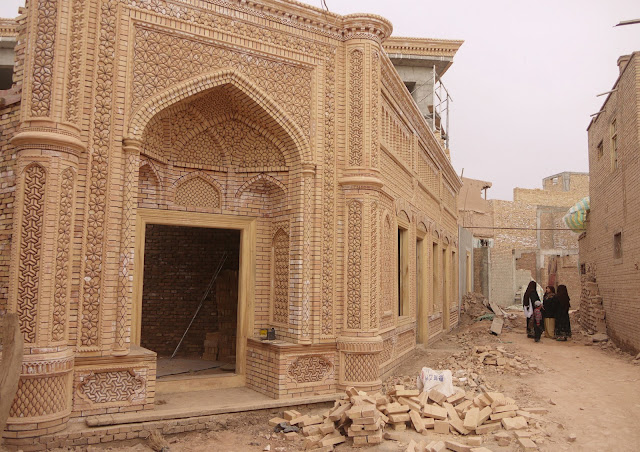Four days after trying to cross the Tian Shan mountains for the first time, I tried it again. This time, the bus was full of tough Russian women who were active in the cross-border trade between China and Kazakhstan, and everything went well. When we had finally managed to cross the frontier (after at least a dozen checks by Kazakh and Chinese border police), we celebrated our success in a Chinese restaurant:

Having arrived the next morning in Urumqi, I right away took another bus to Kashgar, as I wanted to be in time for Kashgar's famous Sunday market.
After a bumpy ride along the Western fringes of the Taklamakan, we got to Kashgar on Friday morning, just in time for the big Friday prayer.
While the prayer was going on, the side streets around Kashgar's central mosque were full of heavily armored riot police, a testimony to the considerable tensions between the native Muslim Uyghurs and the Han Chinese who are settling in ever greater numbers in China's westernmost province of Xinjiang.
After the prayer, the narrow streets were crowded with men coming out of the city's many mosques.
Kashgar's old centre still has a very distinctive silk road feel. The busy streets smell of dust, spices and charcoal fires.
Walking along, one can see Uyguhr craftsman chiselling away, traders offering their goods, watermelons being cut and food being prepared, while old men meditatively strike their beards, observing the hustle and bustle.
In a side street, a man in a shop full of strange bottles, flask and decanters was selecting a number of wiggeling scorpions into a bowl, for a special client.
Around the corner, another man was selling small bottles full of a magic potion, whose beneficial properties were discussed by interested passers-by.
On the dimly-lit gold bazar, women in colourful veils examined rings, chains and other golden ornaments.
Already during the times of Marco Polo, tea bricks were used both as a way to store tea and as currency along the silk road. They can still be bought today in Kashgar's narrow streets.
Unfortunately, Kashgar's old town centre is getting smaller every year, as a sea of Chinese urbanity is slowly encroaching upon the old city's mud-built structures.
Many buildings in the old town are no longer inhabited, and are slowly crumbling away.

Critics say that the decay is deliberate, as the government tries to resettle the unruly Uyghurs out of their old city centre into new appartment blocks around the city, where they will be easier to control. However, the government argues that re-settlement is due to most of the old mud-brick buildings being unsafe in the case of earthquakes. In defense of the government, one has to say that there is also a lot of reconstruction work going on, with buildings being re-build and restored in a way that tries to safeguard traditional architectural styles.
Still, there is probably a risk that after being restored, these new buildings will host souvenir shops for the ever growing numbers of Chinese tourists, rather than the scorpion and magic potion sellers that lived in these streets before.

Having arrived the next morning in Urumqi, I right away took another bus to Kashgar, as I wanted to be in time for Kashgar's famous Sunday market.
While the prayer was going on, the side streets around Kashgar's central mosque were full of heavily armored riot police, a testimony to the considerable tensions between the native Muslim Uyghurs and the Han Chinese who are settling in ever greater numbers in China's westernmost province of Xinjiang.
After the prayer, the narrow streets were crowded with men coming out of the city's many mosques.
Kashgar's old centre still has a very distinctive silk road feel. The busy streets smell of dust, spices and charcoal fires.
Walking along, one can see Uyguhr craftsman chiselling away, traders offering their goods, watermelons being cut and food being prepared, while old men meditatively strike their beards, observing the hustle and bustle.
In a side street, a man in a shop full of strange bottles, flask and decanters was selecting a number of wiggeling scorpions into a bowl, for a special client.
On the dimly-lit gold bazar, women in colourful veils examined rings, chains and other golden ornaments.
Already during the times of Marco Polo, tea bricks were used both as a way to store tea and as currency along the silk road. They can still be bought today in Kashgar's narrow streets.
Unfortunately, Kashgar's old town centre is getting smaller every year, as a sea of Chinese urbanity is slowly encroaching upon the old city's mud-built structures.
Many buildings in the old town are no longer inhabited, and are slowly crumbling away.

Critics say that the decay is deliberate, as the government tries to resettle the unruly Uyghurs out of their old city centre into new appartment blocks around the city, where they will be easier to control. However, the government argues that re-settlement is due to most of the old mud-brick buildings being unsafe in the case of earthquakes. In defense of the government, one has to say that there is also a lot of reconstruction work going on, with buildings being re-build and restored in a way that tries to safeguard traditional architectural styles.
Still, there is probably a risk that after being restored, these new buildings will host souvenir shops for the ever growing numbers of Chinese tourists, rather than the scorpion and magic potion sellers that lived in these streets before.






























your blog is just amazing, It is like travelling with you.
ReplyDeleteBacione
Maria